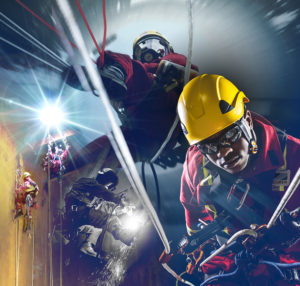 Thank you for choosing Acuren/Tacten Inc. as your rope access training provider. The links below will take you to all of the documents necessary for this class.
Thank you for choosing Acuren/Tacten Inc. as your rope access training provider. The links below will take you to all of the documents necessary for this class.
Acuren/Tacten Specific Documents
IRATA Specific Docs
SPRAT Specific Documents
Canada Specific Documents
Equipment Manufacture Documents
YouTube Training Links
LEVEL 1
LEVEL 2/3
LEVEL 3
KNOTS
The first thing you need to know about rope access
To work safely in rope access requires those engaged in the work to have an appropriate attitude and aptitude. A good level of fitness and physical capability is also required. If unsure, an appraisal session should be arranged with an IRATA International trainer member company. An aptitude for work at height includes not only having ‘a head for heights’, but also an appropriate level of responsibility and self- reliance. A healthy respect for heights remains an advantage; over-confident or reckless workers may present greater risks than the cautious.This course can be physically demanding
Candidates should be physically fit and unaffected by any disability or medical condition that may prevent them from working safely. They shall ensure that they have an adequate level of fitness, are physically able to perform the tasks expected in terms of strength, agility and co-ordination, and are able to withstand the stresses of the working environment, such as heat, cold, and other inclement weather. Candidates are required to certify that they do not have any medical disabilities or contra- indications that may prevent them from working safely. The minimum requirement is a self-certification statement, see IRATA form 014, Statement of medical condition (attached). If a candidate has a contra-indicated condition which is controlled with medication, he/she shall obtain a signed doctor’s note to show training member company or employer that the condition should not prevent that person doing rope access work providing they have access to the required medication.Progressing to a higher level or revalidating at your current level?
Candidates should consider their experience carefully before attempting to progress to a higher level. Candidates without appropriate experience, adequate pre-assessment training and knowledge of the syllabus are unlikely to meet the required standard when assessed. Candidates applying to upgrade shall be competent in all practical and theory requirements of their current level prior to attendance of an upgrade course (e.g. an existing Level 1 attending a Level 2 course shall be capable of performing all Level 1 techniques and answering Level 1 theory questions prior to the start of a Level 2 course.) Candidates who are not competent at their existing level may require additional training. As little time is available on upgrade courses for refresher training, pre-course evaluation is recommended to verify the candidates’ current level of competence. NOTE: For the avoidance of confusion, 1 years’ experience means a Technician is eligible for upgrade assessment on the calendar day one year and one day after their previous assessment. E.g. 1st April 2014 Level 1 assessment, 2nd April 2015 earliest possible L2 assessment. Rope access Technicians who are upgrading or revalidating shall provide their logbooks to the IRATA International trainer member company at the start of the training course. Where rope access Technicians have lost their logbooks, they shall arrange for a replacement to be issued, completed and verified before assessment. IMPORTANT! NO Logbook, NO assessment, this is a hard IRATA rule Assessors abide strictly. Any issue regarding logbooks please contact your hiring manager or the trainer member company, before arrival.What should I wear?
Sneakers, hiking boots, work boots are all acceptable. You may choose to wear work boots to get accustomed to climbing in them. A short or long sleeved shirt and long pants or gym type clothing are ideal clothing to be comfortable as you can be while suspended in a climbing harness.How long is the course?
Training is 8am to approximately 4pm (or later) Monday to Thursday. Break for lunch is around 11:30, for an hour. It is suggested that unless you have your own transportation that you bring your lunch. Please only park in Acuren/Tacten designated parking areas as some of our facilities are shared with other companies. You can expect homework nightly with the advanced levels having more extensive homework than the Level 1’s. Assessment day, Friday, usually starts at 8am depending on Assessor request. Finish time for Level 1’s varies usually taking 4 to 7 hours with 5 1/2 being the average for most students. Level 2’s & 3’s between 6 and 10 hours. Please note that these times are all subject to change.Assessment Day
The purpose of the assessment is to ensure that each candidate demonstrates the required tasks in a safe manner, in accordance with the requirements of this scheme. The Assessor shall not require tasks that are outside the relevant syllabus. The assessment is in two parts: written and practical. Where appropriate, the Assessor may explore the candidate’s knowledge further by discussion. Candidates may be asked to carry out an exercise or exercises that include more than one element of the assessment. There are two possible overall results: pass or fail. To pass the assessment, the candidate shall successfully complete all the required elements of the syllabus at the relevant level. The assessment ends and the candidate fails if one major discrepancy or three minor discrepancies are committed during the assessment.Partner With an Industry Leader Today
Our experienced service providers are ready to deliver innovative, reliable solutions tailored to enhance your efficiency, reduce risks, and optimize costs.
Contact Acuren
Additional Services
Engineering
Acuren’s world-class teams of over 100 engineers have extensive experience both in the field and in our laboratories to provide a higher level of reliability.
Learn More →Inspection
Acuren offers you an unrivaled spectrum of traditional and advanced nondestructive testing and NDE methods to ensure cost-effective and accurate inspection results.
Learn More →Rope Access
As a pioneer in rope access, Acuren has been working to save time and money on projects in difficult to reach and limited access areas for the past 20 years.
Learn More →Success Stories
Flare Stack - Extending Operating Life of Critical Legacy Asset
Integration across Acuren service lines achieves cost-effective and timely asset life extension This oil and gas customer had a 60-year-old flare stack with cracking and corrosion that was approaching its...
Learn More →Solution Brief - Acuren Partners with An Energy Leader to Provide Access Solutions
Problem Acuren has partnered with an energy company to support their TA/Maintenance program in Fort McMurray, Canada Launched in the fall 2016, an access planner works with planning and execution...
Learn More → Thank you for choosing Acuren/Tacten Inc. as your rope access training provider. The links below will take you to all of the documents necessary for this class.
Thank you for choosing Acuren/Tacten Inc. as your rope access training provider. The links below will take you to all of the documents necessary for this class.